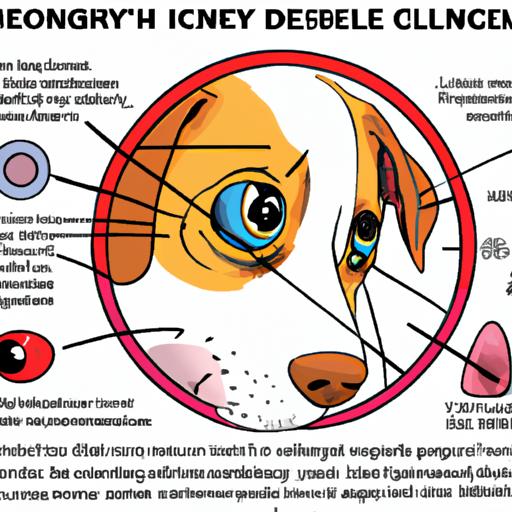Understanding Conjunctivitis in Dogs
You, the caregiver, may often wonder: just how does your beloved pet get conjunctivitis? This eye condition, commonly known as ‘pink eye’, is an inflammation or infection of the conjunctiva, the transparent membrane that lines your dog’s eyelids and covers the white part of their eyes. Conjunctivitis can affect one or both eyes, causing redness, itching, and a nasty green or yellow discharge.
Causes of Conjunctivitis in Dogs
Conjunctivitis in dogs can be caused by various factors. Let’s look at them in detail:
- Allergies: Just as in humans, dogs can also have allergic reactions to substances like dust, pollen, or certain foods. These allergies can irritate the eyes and lead to conjunctivitis.
- Infections: Bacterial, viral, or fungal infections can all cause conjunctivitis. These infections can be due to poor hygiene, exposure to contaminated surfaces, or other sick dogs.
- Foreign Bodies: If a foreign object such as a blade of grass or a speck of dust gets into your dog’s eye, it can cause irritation and potentially lead to conjunctivitis.
- Underlying Diseases: Certain diseases, such as distemper or canine hepatitis, can also cause conjunctivitis as a secondary symptom.
| Cause | Details |
|---|---|
| Allergies | Dust, pollen, certain foods |
| Infections | Bacterial, viral, fungal |
| Foreign Bodies | Grass, dust, other particles |
| Underlying Diseases | Distemper, canine hepatitis |
Symptoms of Conjunctivitis in Dogs
As a vigilant caregiver, you’ll want to know what signs to look out for. Symptoms of conjunctivitis in dogs include:
- Red, swollen eyes
- Excessive tearing or discharge
- Frequent blinking or squinting
- Pawing or rubbing at the eyes
- Visible discomfort or changes in behavior
Treatment and Prevention of Conjunctivitis
Treatment of conjunctivitis in dogs usually involves eye drops or ointments prescribed by a veterinarian. If an underlying disease is causing the conjunctivitis, additional treatment may be necessary.
Prevention is as simple as maintaining good hygiene and minimizing exposure to potential allergens and irritants. Regularly clean your dog’s eyes with a soft, damp cloth, and keep them protected from dust and harsh weather conditions.
FAQ Section
Q: Can humans get conjunctivitis from dogs?
A: Generally, no. Canine conjunctivitis is usually not contagious to humans.
Q: How long does conjunctivitis last in dogs?
A: With proper treatment, symptoms usually improve within a few days.
Q: Is conjunctivitis in dogs painful?
A: Yes, it can cause discomfort and irritation. If your dog seems to be in pain, contact your vet immediately.
Q: Can I treat my dog’s conjunctivitis at home?
A: Home remedies may alleviate symptoms, but it’s always best to consult a vet for proper diagnosis and treatment.
With the right information and a vigilant eye, you, the caring caregiver, can help your furry friend avoid the discomfort of conjunctivitis. After all, a healthy dog is a happy dog!



